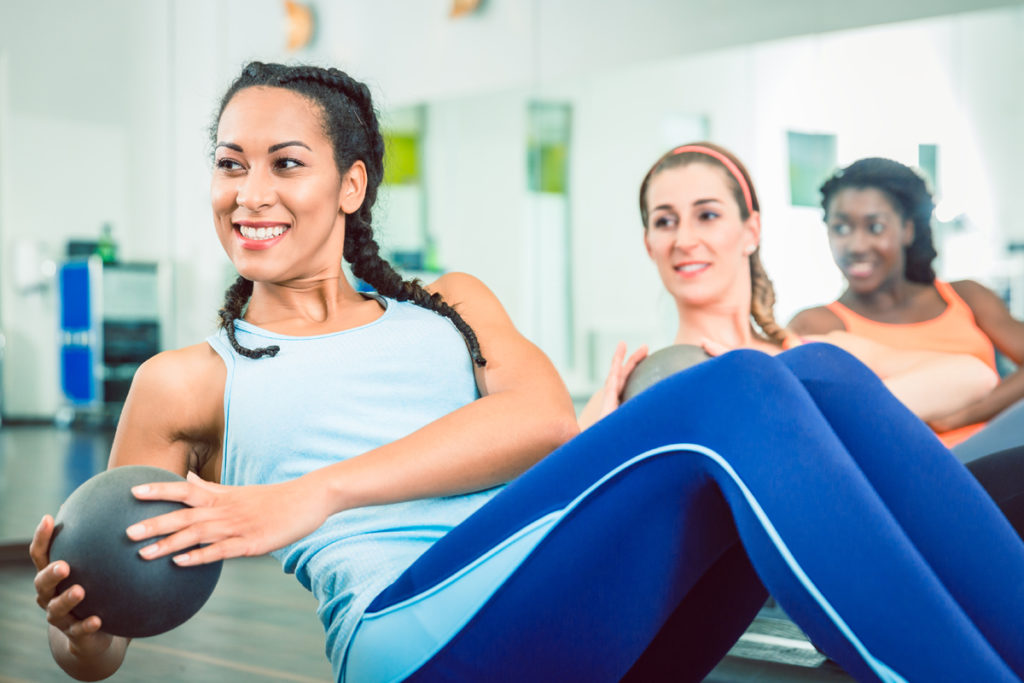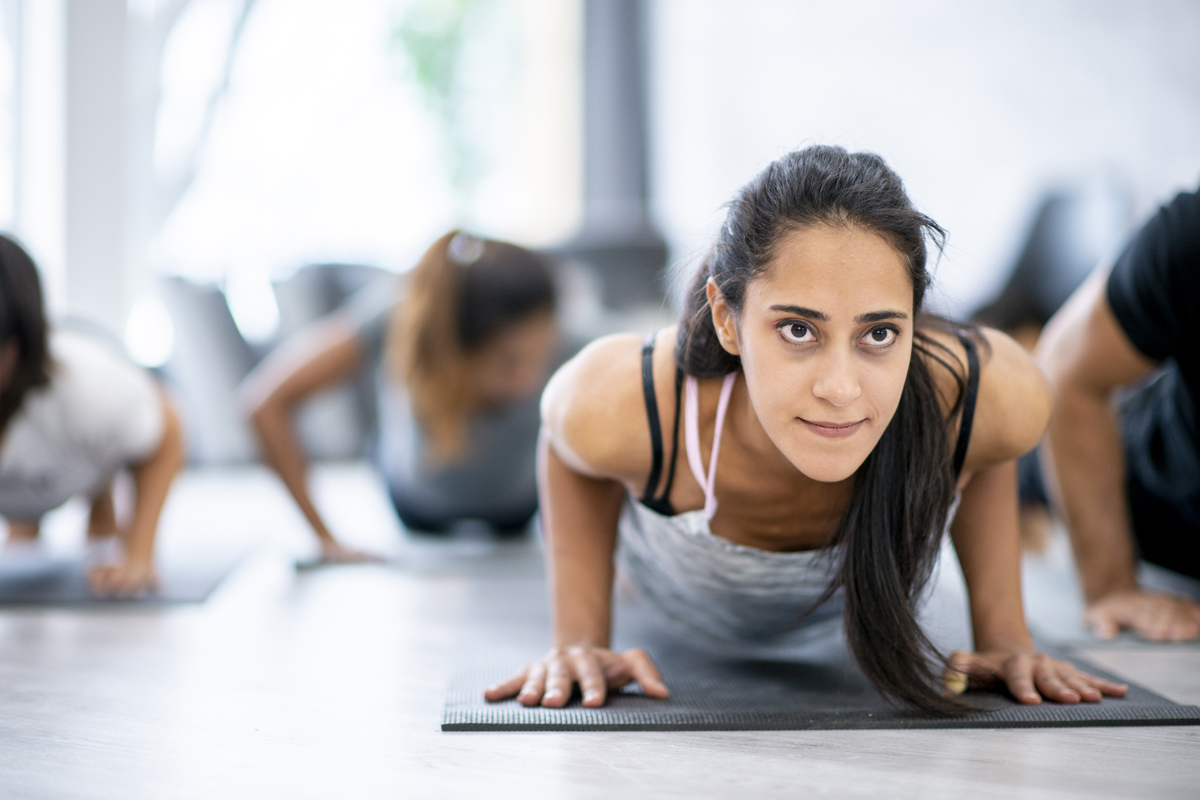Sample Class: Mindfulness and Strength
Cross-training that combines challenging strength exercises with mindfulness and gentler movements to improve flexibility and balance.

If you teach high-intensity classes, you may have noticed that many of your devoted students don’t take advantage of gentler options, such as restorative yoga, foam rolling or low-impact classes. Cross-training is necessary for peak fitness and reduced injury risk, yet persuading participants to try something new or different is not so easy. This class, Mindfulness and Strength, prioritizes mindfulness and flexibility. The workout includes challenging strength exercises that will appeal to your hardworking participants, along with gentler movements that improve flexibility and balance.
Mindfulness and Strength Details
Format: a mix of muscular strength, balance and flexibility
Goal: to introduce aspects of self-care and recovery in a strength class
Time: 60 minutes
Equipment: weighted bars and dumbbells
Music: Choose music with fewer lyrics (to create a calm class experience); 125–130 beats per minute.
Additional details:
-
- This workout features three exercise blocks that repeat in a ladder format to challenge attendees who are accustomed to a traditional high-intensity strength training class.
-
- The strength exercises target multiple muscle groups, to add challenge.
-
- Balance exercises provide an extra functional component that will help students hit their training goals.
-
- A focus on breath encourages people to cultivate mindfulness throughout the workout.
- Flexibility exercises offer recovery and rest between balance and strength sets.
Warmup (10 minutes)
Cycle through the following exercises, performing each move for 10 repetitions per set. Complete 4 sets.
-
- Standing cat-cow: Stand with feet hip-width apart. Bend knees slightly, place hands on thighs, and slowly flex and extend spine.
-
- Squat: Stand with feet hip-width apart. Bend knees and flex slightly at hips; return to starting posi­tion. Increase range of motion with each new set.
-
- Plank with shoulder tap: Begin in plank position (top of pushup). Shift weight slightly and bring right hand to left shoulder, keeping hips level. Repeat, other side.
- Modified pushup: Start in modified plank position, hands and knees on floor, and slowly lower body toward floor. Return to starting position and repeat.
Work Phase (40 minutes)

Repeat each block 3x, reducing the number of reps in each cycle. Do each strength and balance exercise 12x each, then 10x, then 8x. After each round, hold the stretch for 30 seconds.
BLOCK ONE: LOWER-BODY STRENGTH AND STRETCH
Strength: Prone squat: Begin in plank position. Reach hips back toward heels while keeping knees close to floor, core engaged. Return to starting position; repeat.
Balance: Flowing warrior III: Stand with feet hip-width apart. Hinge forward from hips while extending L leg back until parallel to floor. Return to starting position; repeat R.
Stretch: Standing pigeon: Stand with feet hip-width apart. Shift weight to R leg and cross L ankle over R thigh. Bend R knee and hinge forward from hips. Repeat, other side.
Alignment tip: Maintain neutral spine when hinging forward from hips.
Progression: Add resistance to warrior flow by holding dumbbells.
Regression: Reduce ROM when doing flowing warrior.
BLOCK TWO: CORE STRENGTH AND STRETCH
Strength: V-sit twist: Begin seated, holding weighted bar at chest. Lean back slightly, spine extended. Rotate torso to face R and then L.
Balance: Shoulder raise with lateral spinal flexion: Stand in neutral and hold bar with wide grip. Lift bar overhead and shift weight to R leg as you extend L leg to side. Flex spine R, bringing ribs toward hip. Return to starting position and repeat, other side.
Stretch: Seated twist: Start seated, legs crossed. Reach arms overhead to lengthen spine. Rotate torso R, placing L hand on R knee and R hand on floor behind hips. Use arms as leverage to gently increase twist.
Alignment tip: Move in slow, controlled manner when twisting.
Progression: Increase ROM for twisting exercises.
Regression: Do V-sit twist without resistance.
BLOCK THREE: UPPER-BODY STRENGTH AND STRETCH
Strength: Quadruped row: Hold weights while in quadruped position (hexagonal dumbbells tend to be easier, owing to their flat surface). Perform alternating rows, keeping core strong as elbows lift toward ceiling.
Balance: Alternating chest fly: From supine tabletop position (feet off floor, knees over hips), hold weights above chest, palms facing in. Abduct R arm, keeping elbow slightly bent. Return to starting position. Repeat L.
Stretch: Forward fold with chest expansion: Stand with feet hip-width apart and fold forward from hips. Clasp hands behind back and slowly extend at shoulder joint.
Alignment tip: Avoid arching back.
Progression: Do row with knees 1 inch off floor.
Regression: Do chest fly with feet on floor.
Final Stretch (10 minutes)

Hold each of the following for 1 minute each:
-
- Hamstring stretch: Begin in supine, knees bent and feet on floor. Extend R knee and reach foot toward ceiling. Gently pull R leg toward nose; repeat L.
-
- Quadriceps stretch: Begin in prone position and bend R knee. Reach back and bring heel in toward buttock; repeat L.
-
- Cat-cow: Begin in quadruped position with neutral spine. Alternate between flexing and extending spine, keeping movements gentle.
-
- Child’s pose: From hands and knees, reach hips back toward feet, arms extended forward.
- Final relaxation: Lie in supine position, palms up. Close eyes and finish with several deep breaths.
Melissa Weigelt, MS
Melissa Weigelt is an ACE-certified group fitness instructor, NASM-certified personal trainer and vinyasa yoga instructor with 20 years of experience in the fitness industry. As an ACE- and AFAA-approved provider of continuing education for fitness instructors and a member of the BOSU® master trainer and development team, she enjoys sharing her knowledge and ideas with others.





